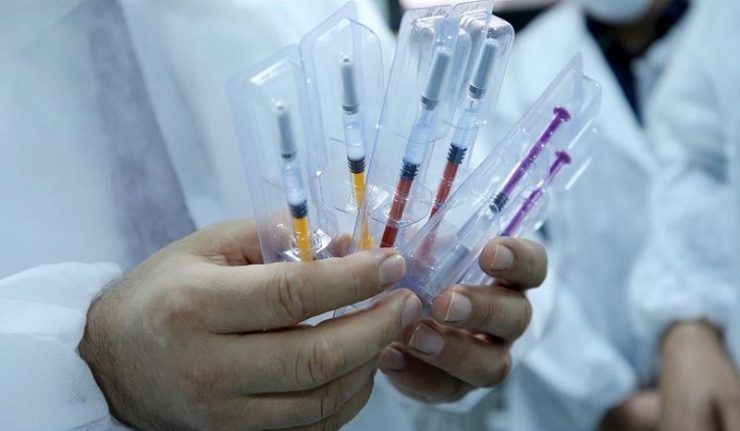PROTECT YOUR DNA WITH QUANTUM TECHNOLOGY
Orgo-Life the new way to the future Advertising by AdpathwayBefore a cell can split into two, it must first copy all of its chromosomes so each new cell inherits a complete set of genetic material. For years, researchers believed that as this process unfolded, the genome's intricate three-dimensional shape temporarily vanished.
After division, scientists thought, the DNA would slowly rebuild its complex, folded structure, which is key to regulating which genes are active in a given cell.
Now, new research from MIT reveals that this long-accepted model isn't quite right. Using a powerful, high-resolution genome mapping method, the team found that small 3D loops -- connections between regulatory DNA elements and genes -- remain intact even during cell division, a stage known as mitosis.
"This study really helps to clarify how we should think about mitosis. In the past, mitosis was thought of as a blank slate, with no transcription and no structure related to gene activity. And we now know that that's not quite the case," says Anders Sejr Hansen, an associate professor of biological engineering at MIT. "What we see is that there's always structure. It never goes away."
DNA Loops That Help Cells "Remember"
The researchers also discovered that these DNA loops actually strengthen as chromosomes condense in preparation for division. This tightening brings distant regulatory elements closer together, encouraging them to stick. According to the team, this could allow cells to "remember" which genetic interactions existed before division and reestablish them afterward.
"The findings help to bridge the structure of the genome to its function in managing how genes are turned on and off, which has been an outstanding challenge in the field for decades," says Viraat Goel PhD '25, the lead author of the study.
Hansen and Edward Banigan, a research scientist at MIT's Institute for Medical Engineering and Science, are senior authors of the study, published in Nature Structural and Molecular Biology. Co-authors include MIT professors Leonid Mirny and Gerd Blobel of the University of Pennsylvania's Perelman School of Medicine.
Mapping the Hidden Architecture of DNA
Over the last two decades, scientists have uncovered that DNA in the cell nucleus organizes itself into 3D loops. Many of these loops allow genes to interact with distant regulatory regions -- sometimes millions of base pairs apart -- while others form during mitosis to pack chromosomes tightly.
Most of this mapping has relied on a tool called Hi-C, a technique co-developed by MIT researchers and Job Dekker at the University of Massachusetts Chan Medical School. Hi-C works by cutting DNA into small fragments and linking together those that are near each other in the cell nucleus before sequencing them to identify which regions interact.
While effective, Hi-C lacks the resolution needed to detect fine-scale interactions between genes and regulatory sequences known as enhancers. Enhancers are short DNA segments that activate genes by binding to promoters, the regions where transcription begins.
A Breakthrough Tool: Region-Capture Micro-C
In 2023, Hansen and colleagues developed a next-generation technique that can map genome structures with up to 1,000 times greater precision. The method, called Region-Capture Micro-C (RC-MC), uses a different enzyme to cut DNA into evenly sized fragments and focuses on a smaller portion of the genome. This allows researchers to create highly detailed 3D maps of targeted DNA regions.
Using RC-MC, the team identified a new structural feature they named "microcompartments." These are tiny, densely connected loops that form when nearby enhancers and promoters attach to one another.
Earlier work had shown that microcompartments formed by a different mechanism than larger 3D genome structures, but the team didn't yet understand how. To explore this, they decided to examine what happens to these structures as cells go through mitosis. During this phase, chromosomes compact dramatically to ensure they can be duplicated and evenly distributed between daughter cells. As this occurs, large genome domains known as A/B compartments and topologically associating domains (TADs) typically disappear.
Unexpected Stability During Cell Division
The researchers expected microcompartments to vanish as well. To test this, they monitored cells throughout the entire division cycle to see how these loops behaved before and after mitosis.
"During mitosis, it has been thought that almost all gene transcription is shut off. And before our paper, it was also thought that all 3D structure related to gene regulation was lost and replaced by compaction. It's a complete reset every cell cycle," Hansen says.
To their surprise, the loops didn't disappear. In fact, they became even more pronounced as cells divided.
"We went into this study thinking, well, the one thing we know for sure is that there's no regulatory structure in mitosis, and then we accidentally found structure in mitosis," Hansen says.
Using their technique, the researchers also confirmed that larger structures such as A/B compartments and TADs do disappear during mitosis, as had been seen before.
"This study leverages the unprecedented genomic resolution of the RC-MC assay to reveal new and surprising aspects of mitotic chromatin organization, which we have overlooked in the past using traditional 3C-based assays. The authors reveal that, contrary to the well-described dramatic loss of TADs and compartmentalization during mitosis, fine-scale "microcompartments" -- nested interactions between active regulatory elements -- are maintained or even transiently strengthened," says Effie Apostolou, an associate professor of molecular biology in medicine at Weill Cornell Medicine, who was not involved in the study.
Explaining a Mysterious Burst of Gene Activity
The discovery may also explain a long-observed burst in gene transcription that occurs near the end of mitosis. Since the 1960s, scientists believed transcription stopped entirely during cell division. However, studies in 2016 and 2017 revealed a brief spike of gene activity before it shuts down again.
In their new study, the MIT team found that during mitosis, microcompartments are more likely to be found near the genes that spike during cell division. They also discovered that these loops appear to form as a result of the genome compaction that occurs during mitosis. This compaction brings enhancers and promoters closer together, allowing them to stick together to form microcompartments.
Once formed, the loops that constitute microcompartments may activate gene transcription somewhat by accident, which is then shut off by the cell. When the cell finishes dividing, entering a state known as G1, many of these small loops become weaker or disappear.
"It almost seems like this transcriptional spiking in mitosis is an undesirable accident that arises from generating a uniquely favorable environment for microcompartments to form during mitosis," Hansen says. "Then, the cell quickly prunes and filters many of those loops out when it enters G1."
Because chromosome compaction can also be influenced by a cell's size and shape, the researchers are now exploring how variations in those features affect the structure of the genome and in turn, gene regulation.
"We are thinking about some natural biological settings where cells change shape and size, and whether we can perhaps explain some 3D genome changes that previously lack an explanation," Hansen says. "Another key question is how does the cell then pick what are the microcompartments to keep and what are the microcompartments to remove when you enter G1, to ensure fidelity of gene expression?"
The research was funded in part by the National Institutes of Health, a National Science Foundation CAREER Award, the Gene Regulation Observatory of the Broad Institute, a Pew-Steward Scholar Award for Cancer Research, the Mathers Foundation, the MIT Westaway Fund, the Bridge Project of the Koch Institute and Dana-Farber/Harvard Cancer Center, and the Koch Institute Support (core) Grant from the National Cancer Institute.


 15 hours ago
1
15 hours ago
1


















.jpg)






 English (US) ·
English (US) ·  French (CA) ·
French (CA) ·